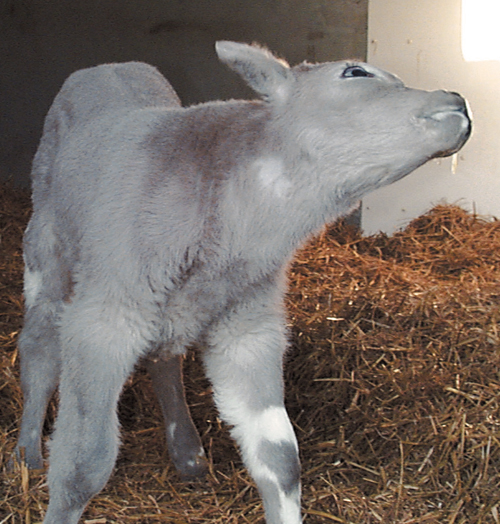Difference between revisions of "Cattle Medicine Q&A 07"
(Created page with "{{Template:Manson}} centre|500px <br /> '''A 5-day-old Charolais-cross beef calf has been dull and unwilling to suckle from the cow for the pas...") |
|||
| (3 intermediate revisions by 3 users not shown) | |||
| Line 1: | Line 1: | ||
| − | {{Template:Manson | + | {{Template:Manson}} |
[[Image:Cattle Medicine 7.jpg|centre|500px]] | [[Image:Cattle Medicine 7.jpg|centre|500px]] | ||
| Line 15: | Line 15: | ||
*bacterial meningoencephalitis | *bacterial meningoencephalitis | ||
*septicaemia. | *septicaemia. | ||
| − | |||
|q2=How could you confirm your diagnosis? | |q2=How could you confirm your diagnosis? | ||
|a2= | |a2= | ||
| Line 23: | Line 22: | ||
*comprised almost entirely of neutrophils (neutrophilic pleocytosis). | *comprised almost entirely of neutrophils (neutrophilic pleocytosis). | ||
The total plasma protein of 48 g/L (4.8 g/dL) indicates failure of passive antibody transfer (normal value for calves that have sucked colostrum >65 g/L, <6.5 g/dL). | The total plasma protein of 48 g/L (4.8 g/dL) indicates failure of passive antibody transfer (normal value for calves that have sucked colostrum >65 g/L, <6.5 g/dL). | ||
| − | |||
|q3=What is the likely cause? | |q3=What is the likely cause? | ||
|a3= | |a3= | ||
''Escherichia coli, Pasteurella spp., Staphylococcus pyogenes'', and ''Arcanobacterium pyogenes'' have been isolated from clinical cases of meningoencephalitis. ''E. coli'' is the most common isolate from septicaemic calves. | ''Escherichia coli, Pasteurella spp., Staphylococcus pyogenes'', and ''Arcanobacterium pyogenes'' have been isolated from clinical cases of meningoencephalitis. ''E. coli'' is the most common isolate from septicaemic calves. | ||
| − | |||
|q4=What treatment(s) would you administer? | |q4=What treatment(s) would you administer? | ||
|a4= | |a4= | ||
The calf was treated with high doses of intravenous trimethoprim/sulphonamide and soluble corticosteroid (dexamethasone at 1.0 mg/kg). | The calf was treated with high doses of intravenous trimethoprim/sulphonamide and soluble corticosteroid (dexamethasone at 1.0 mg/kg). | ||
| − | |||
|q5=What is the prognosis for this calf? | |q5=What is the prognosis for this calf? | ||
|a5= | |a5= | ||
| − | The calf improved over the next 24 hr | + | The calf improved over the next 24 hr |
| − | |||
</FlashCard> | </FlashCard> | ||
| − | |||
| − | |||
| − | |||
| − | |||
| − | |||
| − | |||
| − | |||
| − | |||
| − | |||
| − | |||
| − | |||
| − | |||
| − | |||
| − | |||
| − | |||
{{#tag:imagemap|Image:Next Question.png{{!}}center{{!}}200px | {{#tag:imagemap|Image:Next Question.png{{!}}center{{!}}200px | ||
Revision as of 18:14, 12 April 2011
| This question was provided by Manson Publishing as part of the OVAL Project. See more [[:Category:{{{book}}}|{{{book}}}]]. |
A 5-day-old Charolais-cross beef calf has been dull and unwilling to suckle from the cow for the past 6 hr. The rectal temperature is 39.2°C (102.6°F). The calf is depressed and stands with a wide-based stance with the neck extended. The menace response is reduced and there is marked episcleral congestion and dorso medial strabismus. The respiratory rate is increased at 60 breaths per minute. The umbilicus had been treated with strong iodine solution and appears normal. There is no evidence of diarrhoea. The lymph nodes are not enlarged.
| Question | Answer | Article | |
| What conditions would you consider? | The most likely conditions to consider include:
|
[[|Link to Article]] | |
| How could you confirm your diagnosis? | Diagnosis of meningoencephalitis follows lumbar CSF collection under local anaesthesia using a 20 gauge 25 mm hypodermic needle. The sample is turbid, caused by the influx of white cells, and has a frothy appearance after sample agitation due to the increased protein concentration. Laboratory analysis reveals:
The total plasma protein of 48 g/L (4.8 g/dL) indicates failure of passive antibody transfer (normal value for calves that have sucked colostrum >65 g/L, <6.5 g/dL). |
[[|Link to Article]] | |
| What is the likely cause? | Escherichia coli, Pasteurella spp., Staphylococcus pyogenes, and Arcanobacterium pyogenes have been isolated from clinical cases of meningoencephalitis. E. coli is the most common isolate from septicaemic calves. |
[[|Link to Article]] | |
| What treatment(s) would you administer? | The calf was treated with high doses of intravenous trimethoprim/sulphonamide and soluble corticosteroid (dexamethasone at 1.0 mg/kg). |
[[|Link to Article]] | |
| What is the prognosis for this calf? | The calf improved over the next 24 hr |
[[|Link to Article]] | |
